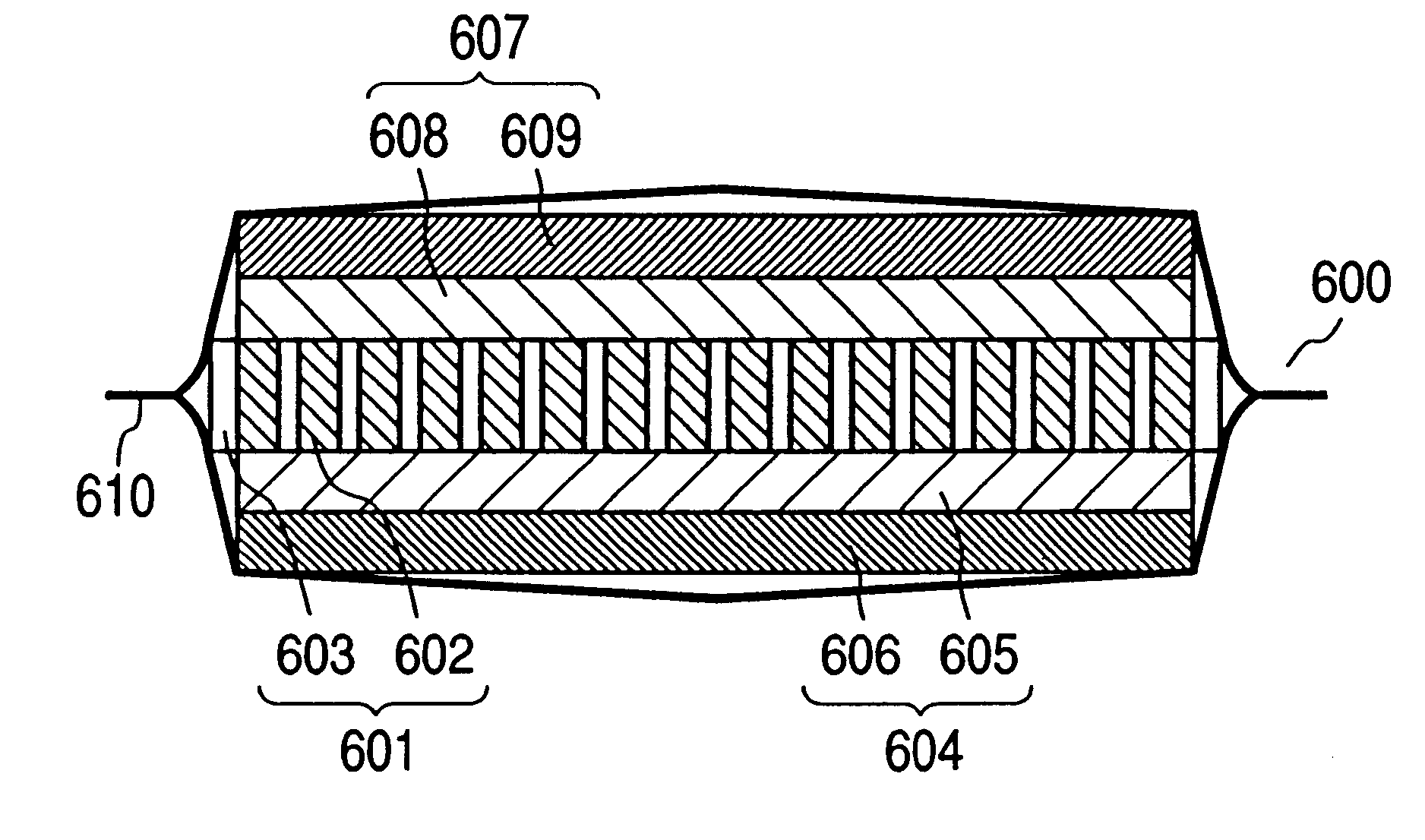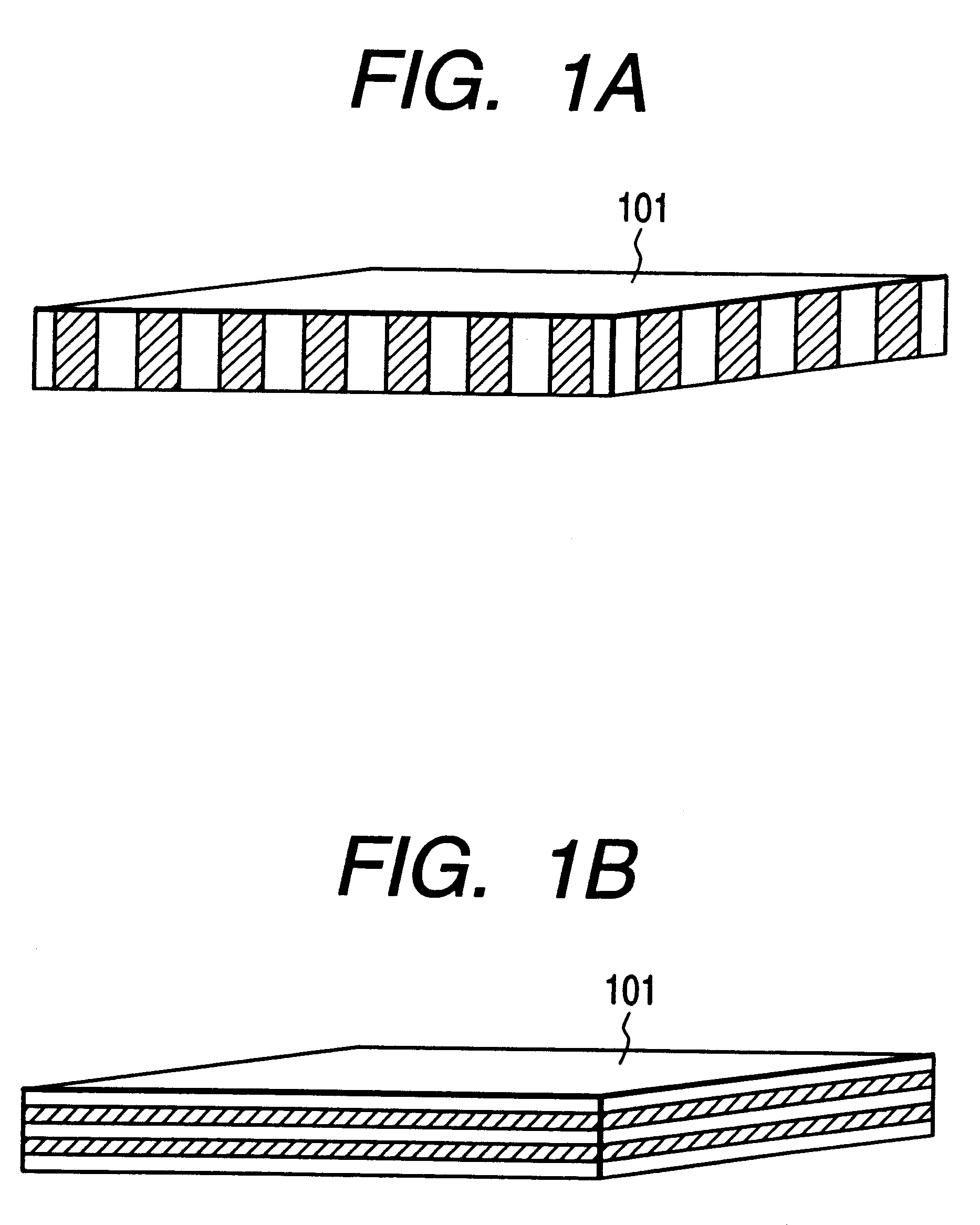Secondary battery having an ion conductive member and manufacturing process thereof
a technology of secondary batteries and conductive components, which is applied in the direction of nickel accumulators, non-aqueous electrolyte cells, cell components, etc., can solve the problems of increasing the internal impedance of secondary batteries, breaking of batteries, and difficulty in building new thermal power stations which emit carbon dioxide gas in large quantities
- Summary
- Abstract
- Description
- Claims
- Application Information
AI Technical Summary
Problems solved by technology
Method used
Image
Examples
embodiment 2
A sheet-like battery constructed as shown in FIG. 6 was manufactured in such a way that a negative electrode and a positive electrode were fabricated and were respectively formed with polymer gel electrolyte layers on their surfaces to be opposed, that the negative electrode and positive electrode were laminated together with the sides of the polymer gel layers opposed to each other, and that the resulting structure was sealed with moisture-proof films. These fabricating steps will be explained with reference to FIG. 6.
(1) Preparation of Granular Polymer Gel
A reaction vessel was filled with dried nitrogen gas. 15.0 parts of polyoxyethylene hexadecylether being a nonionic surfactant, which was employed as a compound having a molecular structure to serve as a template, and 275 parts of ion-exchanged water, were put into the reaction vessel and were agitated. Subsequently, 8.76 parts of diethyleneglycol monomethylether methacrylate and 0.24 part of ethyleneglycol dimethacrylate were ag...
embodiment 3
A sheet-like battery constructed as shown in FIG. 6 was manufactured in such a way that a negative electrode and a positive electrode were fabricated and were respectively formed with polymer gel layers on their surfaces to be opposed, that the negative electrode and positive electrode were laminated together with the sides of the polymer gel layers opposed to each other, and that the resulting structure was sealed with moisture-proof films. These fabricating steps will be explained with reference to FIG. 6.
(1) Preparation of Mixed Monomer Solution Containing Monomers for Formation of Polymer Gel Electrolyte
A mixed solution was prepared in such a way that 70 parts of acrylonitrile as a monomer, 30 parts of 4-(6-acryloyloxyhexyloxy)-4'-cyanobiphenyl as a liquid crystalline monomer, 6.5 parts of 1,6-hexanediol diacrylate as a cross-linking agent, and 5 parts of benzoyl peroxide as an initiator were mixed into 550 parts of an electrolyte solution of 1 mol / liter in which lithium tetrafl...
embodiment 4
A sheet-like battery constructed as shown in FIG. 6 was manufactured in such a way that a negative electrode and a positive electrode were fabricated and were respectively formed with polymer gel layers on their surfaces to be opposed, that the negative electrode and positive electrode were laminated together with the sides of the polymer gel layers opposed to each other, and that the resulting structure was sealed with moisture-proof films. These fabricating steps will be explained below with reference to FIG. 6.
(1) Preparation of Polymer Gel Electrolyte
All operations were performed in an argon gas atmosphere.
1) In a mixed solution consisting of 30 parts of potassium palmitate as a surfactant and 70 parts of ion-exchanged water, nitrogen gas was bubbled for gas substitution. Thereafter, 8.76 parts of ethyleneglycol monomethylether methacrylate as well as 0.24 part of ethyleneglycol dimethacrylate, and 0.03 part of potassium peroxosulfate as a polymerization initiator were added and...
PUM
| Property | Measurement | Unit |
|---|---|---|
| Electrical conductivity | aaaaa | aaaaa |
| Amphiphilic | aaaaa | aaaaa |
| Structure | aaaaa | aaaaa |
Abstract
Description
Claims
Application Information
 Login to View More
Login to View More - R&D
- Intellectual Property
- Life Sciences
- Materials
- Tech Scout
- Unparalleled Data Quality
- Higher Quality Content
- 60% Fewer Hallucinations
Browse by: Latest US Patents, China's latest patents, Technical Efficacy Thesaurus, Application Domain, Technology Topic, Popular Technical Reports.
© 2025 PatSnap. All rights reserved.Legal|Privacy policy|Modern Slavery Act Transparency Statement|Sitemap|About US| Contact US: help@patsnap.com



